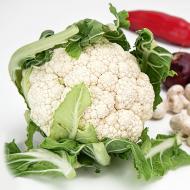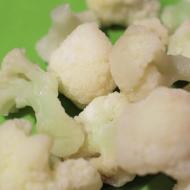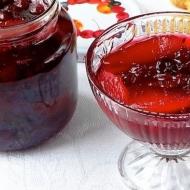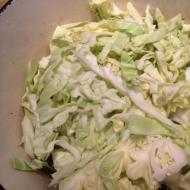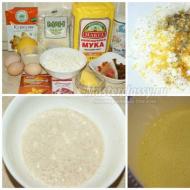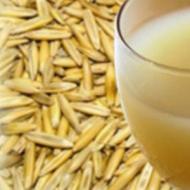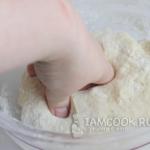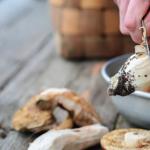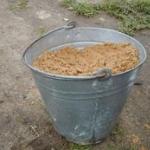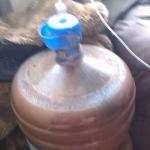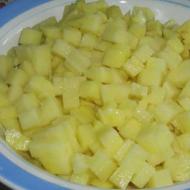
Recipes for delicious pickled cauliflower for the winter. Crispy and delicious cauliflower in tomato sauce. Recipe for making sauerkraut without vinegar at home
Foreword
Cauliflower is much healthier and healthier than white cabbage - it contains more vitamins and trace elements necessary for the body, and it is much easier to digest. It is even recommended for gastrointestinal diseases, but white cabbage is contraindicated in some cases. This storehouse of vitamins is amenable to canning, and cauliflower-based recipes are just licking your fingers.
Most hostesses still prefer to harvest for the winter only and do not even realize that it is possible to preserve and color. They do not know that this is a quick, simple matter, but a variety of recipes for harvesting this vegetable "wagon and a small cart":
- in brine;
- with boiling and without sterilization;
- frozen;
- in the form of ready-made salads.
All recipes for canning cauliflower will almost take a whole book. However, most often only a select few are used. These are the ones shown below. Before you start “conjuring” in the kitchen, you need to choose the right main ingredient - cabbage: only selected inflorescences that do not have black blotches, without insects and pests will do.
Cabbage should be fully ripe - with evenly white heads. The inflorescences of this vegetable are prepared for canning by cutting into small segments or simply broken by hand.
In this recipe, due to tomatoes, the taste of cabbage is richer than usual. The preparation of this assortment is quite simple. It will also require, of course, tomatoes, as well as a marinade, in which 1 liter of filtered water should contain: 3 tbsp. spoons of granulated sugar, 1 tbsp. a spoonful of table salt, vinegar essence - 1 teaspoon and, if desired, any spices in any combination (cherry, horseradish and / or currant leaves, cloves, dill, garlic, black peppercorns and allspice, as well as others to taste) .
Vegetables should be washed, and then the cabbage should be disassembled into inflorescences. We pierce the tomatoes with a wooden skewer or a toothpick in the area of the stalk. We wash the jars well and, preferably, sterilize. Put tomatoes and cabbage in prepared jars. The order of placement is arbitrary, but the vegetables should fill the glass container to the very top, because after cooking they will noticeably settle.
Then pour boiling water into the jars, and cover their necks (do not twist) with pre-sterilized new lids. In this form, we leave the vegetables to stand for about 30 minutes. If other things appear during this time, it's okay, the jars can be left even for several hours. Boiling water is then drained, and it will immediately be seen how much the vegetables have settled.
We put a few peeled garlic cloves, 5–6 peas of pepper (allspice and black), 2–3 cloves in jars. We cook the marinade - many do this on the same water that was drained from the vegetables, however, it is more reliable to use clean water. In boiling water according to the above recipe, pour salt (preferably coarse, not iodized) and sugar. Let the marinade boil for 5-7 minutes, and at the very end add vinegar essence to it. Then you need to pour the marinade into containers with vegetables to the very top, and twist the jars or roll up the lid.
After waiting a few minutes, tighten the lids until they stop. We turn the jars upside down and wrap them with a blanket or other things. Only after the jars have completely cooled down, they are placed to be stored for the winter in a dark, cool place intended for this.
For this recipe, you need to take cauliflower with dense heads, but not overripe. The product prepared for the winter in this way turns out to be crispy, quite spicy and will not only be an excellent side dish for various meat dishes, but also an excellent snack.
The recipe for cabbage is based on a 1-liter jar, and the marinade for it is based on 1 liter of water.
Ingredients:
- cabbage heads - 1–1.5 pcs;
- carrots (at the discretion of the hostess) - 1-2 pcs;
- carnation (buds) - 2-3 pcs;
- black peppercorns - 3-4 pcs;
- sugar - 100 g;
- bay leaf - 2-3 pieces;
- vinegar essence - 45-55 milliliters;
- salt - 70 g.
The order of preparation is as follows. First, the head of cabbage must be separated into separate inflorescences, which are then thoroughly washed. We prepare liter jars - wash and sterilize. After that, put water on the stove and, based on 1 liter, add 1 g of citric acid and 25 g of salt to it. Bring the resulting solution to a boil, and then blanch the inflorescences in it - cook for 3-4 minutes. Then, with a slotted spoon, transfer the cabbage to cold water and let it cool.
At the bottom of the jars lay out the bay leaf, cloves, peppercorns. You can also add a small piece of cinnamon. Then we lay the cabbage, placing it with inflorescences outward (towards the walls). If you wish, you can add peeled, washed and chopped carrots.
We prepare the marinade: dissolve salt, sugar in filtered water; add vinegar essence; bring the resulting mixture to a boil. Then pour the boiling marinade into containers with cabbage. After that, cover the jars with lids and place them for sterilization in boiling water for 8 minutes. We roll the jars upside down under a warm blanket and let them cool. They should be stored in a cool dark place.
To prepare this wonderful salad you will need:
- cabbage - 2 kg;
- Bulgarian pepper (preferably multi-colored) - 1 kg;
- carrots - 1 kg;
- medium zucchini - 2 pcs;
- large head of garlic - 1 pc;
- hot chili pepper (optional) - half a pod without seeds;
- tomato juice (preferably homemade) - 1 l;
- salt (not iodized) - 3 tbsp. spoons;
- vinegar (table) - 1 tbsp. spoon.
First of all, as usual, we wash and clean the vegetables, prepare the jars. Then: disassemble the cauliflower into small inflorescences; cut carrots, peppers and zucchini into strips; pass the garlic through the press. We put everything on the list (except vinegar and garlic) in a saucepan and bring the resulting mass to a boil. Reduce the heat (so that it does not boil too much), and then cook the vegetables in the tomato for 25 minutes. After adding vinegar and peeled garlic, cook the salad for another 5 minutes. We lay out the finished product in sterilized jars.
Filled cans must be rolled up and put on the lids under the covers. We place the cooled salad for the winter for storage in a place where it is dark and cool.
Preservation of cabbage requires effort, albeit small. But freezing it for the winter is quite a simple matter. But this processing method will allow you to save vitamins and useful trace elements in the vegetable almost in full. To implement this recipe, you need free space in the freezer, clean bags and, in fact, the product itself - cauliflower.

Cauliflower is suitable for canning if it meets the following requirements: the inflorescences of the head must be white, mature, healthy, closed with 2-3 rows of integumentary leaves; the heads must be at least 7 cm in diameter, dense, with a tuberculate surface, without germinated inner leaflets. The stems of individual inflorescences should not be too thick and fibrous.
Bare heads are not allowed for production, that is, without a rosette of outer leaves, yellowed (with a tan), dirty, lethargic, loose and with other defects.
Delivery of cabbage to the plant must be carried out on the day of removal in cage boxes with a capacity of not more than 20 kg.
The best varieties of cauliflower for canning are: Perfection (head diameter 12-18 cm, weight 0.5 kg), Snowball (head diameter 12-18 cm, weight 0.8 kg), Snezhinka, Otechestvennaya, Moscow canning, Leningradskaya.
The chemical composition of cabbage is as follows: solids 9%, including: carbohydrates 4.5%, proteins 1.8%. Cauliflower proteins are rich in sulfur. The content of ascorbic acid in cauliflower averages 70 mg%.
The cabbage delivered to the plant is sorted on a conveyor belt according to quality and at the same time manually freed from the outer cover leaves, while rejecting substandard heads. Then the heads are cut into separate inflorescences with a diameter of 3 to 8 cm, from which the thick, rough ends of the pedicels are cut off so that the individual parts of the inflorescences do not fall apart. The cleaned inflorescences go to the sink, which is carried out first in a fan, and then in a shaking washer at a water pressure of 2-3 atm (196-294 kN / m 2).
To protect the cabbage from browning, it is sometimes bleached before blanching, keeping it in a 0.12-0.15% SO 2 solution for 30 minutes. This treatment can significantly improve the color of cabbage. Good results were obtained when cabbage was kept in a 0.2% sulfuric acid solution for 0.5 hours. The content of free sulfurous acid in canned food is standardized by health authorities and should not exceed 0.001%. Prolonged soaking of cauliflower in a bleaching solution causes off-flavours in canned food and the formation of a sulfide film on the inside of unvarnished cans.
Cauliflower inflorescences are blanched in a boiling solution containing 2% common salt and 0.05% citric acid. The duration of blanching is not more than a minute. After blanching, the cabbage is quickly cooled in a shower washer. Prolonged blanching of cabbage can worsen its consistency and cause the inflorescences to turn pink.
Blanching is necessary to break down the coloring matter that gives the cauliflower buds a yellow or green hue. As a result of blanching, cabbage inflorescences lighten (bleach). In addition, when cabbage is heated, unstable sulfur compounds contained in it are removed. The need to remove volatile sulfur compounds is due to their ability to react with the metal of the can and form tin (brown) and iron (black) sulfur salts, which cause darkening of the product.
Sometimes, in the process of canning, cabbage acquires a pink, purple, bluish-black, brownish-black, greenish-black color. This is due to the action of flavonols contained in cabbage, in particular kaempferol and quercetin glucosides, which, reacting with metals (iron, copper), form colored complex compounds. Therefore, such operations of the technological process as blanching, cooling, inspection, as well as short-term storage of cabbage before packing into jars, are carried out on equipment and in containers made of stainless steel or having protective coatings. The use of equipment made of iron or non-ferrous metals should be excluded.
Water and steamed salt used in blanching should not contain iron salts. If iron salts are found in table salt, then it must be recrystallized and re-tested for the absence of iron salts. If there are iron salts in the water, it is recommended to pass it through an iron removal plant or use pure condensate.
Blanching is carried out in stainless steel nets and apparatuses. This process must not be carried out in meshes or apparatuses made of iron or in enamelled apparatuses with damaged enamel.
Blanched cabbage before placing in jars can be stored for no more than 30 minutes in enameled or stainless steel basins with a 1% aqueous solution of sodium chloride or a 0.05% solution of citric acid.
Cabbage is packaged in tin, preferably varnished, or glass jars. Preference is given to tin cans, since the sterilization process in them is faster, the cabbage is less boiled, and its color is better preserved. Before this, the cabbage is inspected, selecting crumpled, crushed or darkened inflorescences. Cabbage is placed in jars tightly with inflorescences outward, peduncle inward. Large inflorescences are cut into pieces from the side of the pedicel. After laying in jars, the cabbage is poured with a 2% solution of common salt, sometimes with the addition of 0.2% citric acid. The filling temperature must be at least 90 ° C. The ratio of the components in the jars is as follows: cabbage - 60%, filling - 40%.
Filled cans are sealed on vacuum-sealing machines, sterilized at 116°C for 12-15 minutes (cans 350-500 g) and quickly cooled to 30-35°C to avoid boiling cabbage. Practice has shown that with this mode of sterilization the consistency of cabbage inflorescences was quite dense.
With a decrease in the pH of the filling from 6.9-7.1 to 4.9-5.1 by adding 0.2% citric acid to it, according to A. T. March, A. L. Feldman, I. S. Kagan and D. Yu. Lyashch (1959), the sterilization temperature of cans with a capacity of 0.5 liters can be reduced to 108 ° C for a duration of 20 minutes.
Canned cauliflower in a glass container is recommended to be stored in a dark place.
In ready-made canned food, the following are normalized: mass of cabbage (not less than 55% of the net weight of canned food), sodium chloride content (0.9-1.3%), acidity in terms of malic acid (not more than 0.15%), SO 2 content (no more than 0.001%).
Canning. 60 Recipes You Don't Know Yet Raisa Savkova
canned cauliflower
I speak in all honesty - I marinated and preserved such cabbage for the first time.
In my mother-in-law, cauliflower in the country is a "low-yielding" vegetable. Marina Ivanovna plants her, takes care of her, and she grows up somehow small and unsightly.
So I decided that, in addition to the assorted salads that Marina Ivanovna rolls, you can pickle a jar or two of cabbage. Just because it's beautiful.
Ingredients:
Cauliflower;
Bay leaf;
Black pepper and allspice peas;
Garlic.
Cooking method
To begin with, we clean the heads of cabbage from the integumentary leaves and divide into inflorescences. Rinse thoroughly under running water. Blanch them in boiling salted water for 2-3 minutes (10 g of salt per 1 liter of water).
After blanching, put the cabbage in prepared (sterilized) jars. At the bottom of each jar we put a bay leaf, black pepper and allspice, a couple of cloves of garlic. Pour the cabbage with boiling brine: for 1 liter of water - 20 g of salt.
Cool upside down. Store in a cool dark place.
From the book Home Canning author Kozhemyakin R. N.Pickled canned cabbage Components White cabbage Allspice, cloves and cumin - to taste To prepare the marinade for 1 liter of water - sugar - 120 g of salt - 50 g of table vinegar - 1 cup Peel the cabbage from the top leaves and stalk, chop and
From the book Big Encyclopedia of Canning author Semikova Nadezhda AlexandrovnaCanned cabbage with vegetables on a large grater,
From The Big Book of Nutrition for Health author Gurvich Mikhail MeerovichCanned cauliflower In this recipe, it is advisable to use jars with reusable glass lids with clips, as the cabbage is pasteurized twice.
From the book Cabbage Pickles. Cooking like a pro! author Krivtsova Anastasia VladimirovnaCanned cauliflower with carrots Ingredients Medium-sized cauliflower - 2 heads Carrots - 1 kg Sugar - 1 tablespoon Salt - per 1 liter of water 45 g of salt Dill umbrellas - 1 bunch Disassemble the cauliflower into buds, soak for 20 minutes in salted
From the author's bookCanned cauliflower with bean pods and peas Components Cauliflower - 2 kg Green beans - 500 g Green pea pods - 500 g Allspice and ground cloves - to taste To prepare the marinade for 1 liter of water - salt - 40 g sugar -
From the author's bookCanned cauliflower Disassemble young, strong, dense white buds into inflorescences, pour salted water and leave for 20-30 minutes. Rinse thoroughly and boil in unsalted water for 7-10 minutes. Arrange in jars and pour filtered boiling brine (1
From the author's book From the author's bookCauliflower, kohlrabi and broccoli (asparagus cabbage) These vegetables contain vitamin C, carotene, vitamin PP, potassium, magnesium, and many other useful substances. All types of cabbage contribute to the regular functioning of the intestines, the release of the body from cholesterol. Dishes from cauliflower
From the author's bookCanned cabbage with prunes? 1 fork white cabbage? 500 g pitted prunes 80 grams of salt? 30 grams of sugar? 4 cloves? 3 peas of allspice? 100 ml of 9% vinegar? 1 liter of water Finely chop the cabbage and rub it lightly. Pour prunes with boiling water
From the author's bookCanned cabbage with ginger? 1 fork white cabbage? 4 carrots, cloves of garlic? 3 bell peppers, tomatoes? 2 onions? 5 sweet peppercorns? 150 g of ginger root? 80 grams of salt? 200 ml vegetable oil? 120 ml 9% vinegar Wash the vegetables and
From the author's bookCanned cauliflower with bell peppers? 2 kg of cauliflower? 2 bell peppers, cloves of garlic For filling:? 100 grams of salt? 50 grams of sugar? 250 ml apple cider vinegar? 2 liters of water Separate the cauliflower into florets. Bring water to a boil, add a little apple
From the author's bookCanned cauliflower with zucchini? 1 kg of cauliflower? 3 zucchini? 2 tomatoes, cloves of garlic? 1 bell pepper, carrot, onion head? 120 grams of salt? 50 grams of sugar? 100 g of tomato paste? 150 ml vegetable oil? 50 ml of 9% vinegar? greenery
From the author's bookCanned cabbage with eggplant? 1 fork of white cabbage, a pod of hot pepper? 3 eggplants? 2 carrots? 5 cloves of garlic? 90 g of salt? 20 grams of sugar? 200 ml vegetable oil? 50 ml 9% vinegar Wash and peel the vegetables. Cut the eggplant into cubes and set aside
From the author's bookCanned Brussels sprouts? 1 kg Brussels sprouts For topping:? 40 grams of salt? 20 grams of sugar? 150 ml of 9% vinegar? 1 liter of water Boil cabbage in salted water for 10-15 minutes. Then drain in a colander and cool slightly. Bring water to a boil, add
From the author's bookCanned cabbage with chanterelles? 1 fork white cabbage? 3 onions? 2 carrots? 400 g of chanterelles? 100 grams of salt? 50 grams of sugar? 250 ml tomato juice? 200 ml vegetable oil Finely chop the onion, grate the carrots on a coarse grater and fry in vegetable oil
From the author's bookCanned cabbage with champignons? 1 fork of white cabbage, bell pepper? 2 onions? 300 g champignons For filling:? 70 grams of salt? 15 grams of sugar? allspice peas? carnation? 50 ml of 9% vinegar? 1 liter of water Mushrooms cut into small pieces
Cauliflower first came to Russia during the time of Catherine II. Initially, it was a very expensive and exclusive product, but today it is available to everyone. Its value lies not only in the fact that it has a special taste, first of all, this cabbage is a low-calorie product and is well absorbed by the body. Therefore, a rare woman will allow herself to miss the opportunity not to close it in a jar before the onset of a cold winter.
Canning cauliflower is presented in many different ways (as is the case with any vegetables), and therefore we will try to describe a few popular options.
canned cauliflower plain
This is the easiest and most affordable recipe. Here you will need products: 600 grams of cabbage, about 300 ml of water, 1 tsp. salt.
Cooking: First of all, the cabbage must be washed and cleaned of black dots (if any). Separating the inflorescences from each other, soak them in a pre-prepared brine for 2 hours. The latter is prepared based on the proportion that 70 grams of salt is enough for 1 liter of water. Then the cabbage is washed with running water, put in sterilized jars and poured again with brine, only now it should be hot and 2% (20 grams of salt should be taken per liter of water). Cover the jars, boil for another 1 hour and cool on a blanket.
Spicy pickled cauliflower
To make the taste of cabbage more refined and original, it must be marinated with a lot more ingredients than in the previous case. For this you can use the following products: 2 kg cauliflower, 5 black peppercorns and the same amount of allspice, 4 pieces of bay leaf, 5 pcs. clove flowers, 5 sprigs of tarragon, 3 grams of citric acid, a pinch of cinnamon (literally on the tip of a knife), 200 ml of vinegar. In addition, for the brine you will need: 1 liter of water, half a tablespoon of sugar, 1 tablespoon of salt.
Cooking: Well-cleaned and washed cabbage must be disassembled into inflorescences, dried so that it is not too wet. Then put in a saucepan and boil a little in water, where citric acid and salt were added (1 tablespoon of salt per 1 liter of water). After that, pull the cabbage out of the water, cool it and put it in clean jars. The preparation of the marinade is very simple. To do this, bring water to a boil, pour sugar, salt and all prepared spices into it, as well as tarragon. Boil everything together for 10 minutes. Lastly, add vinegar and immediately turn off the gas. With freshly prepared hot marinade, carefully pour each jar where cabbage lies, cover with a sterilized lid and put in boiling water for another 15 minutes. After that, they can be rolled up and left to cool.
Cauliflower salad with pepper
In addition to simply pickling cauliflower, pepper salad is also very popular. To prepare it you will need products: 800 grams of cauliflower, 3 (can be 4) pieces of different bell peppers (green, red or yellow), 100 grams of parsley.
Cooking: Rinse, peel and divide the cabbage into inflorescences, cut out the seeds from the pepper and cut it into rings. Chop the parsley. Fold the salad into washed jars, alternating layers of pepper, cabbage and greens. Salt everything on top, pour boiling water. Put in boiling water, cook for about 20 minutes, then add more boiling water and vinegar. Everything, now you can roll up the jar and put it to cool.
Cauliflower with nuts
This is a rather unusual, but still popular recipe for how to roll cauliflower with walnuts into jars. So, products: about 700 grams of cauliflower, 100 grams of nuts, 2 tbsp. vinegar (6%), 150 grams of onion, 30 grams of salt, 3 cloves of garlic, a little ground red pepper (to taste).
To slightly improve the taste of cabbage, it is first cleaned, disassembled into inflorescences, and then blanched in water. This must be done quickly, 5 minutes will be enough. Then rinse it under cold water and place in a bowl. Pour finely chopped onions, chopped nuts, chopped garlic, 6% vinegar, pepper and salt there. All this is well mixed with each other and put in jars prepared for twisting. If the cans are 0.5 liters each, then they need to be boiled for another 15 minutes, if 3 liter - then twice as long, that is, 30 minutes. Then roll up tightly and chill.
P.S. Cauliflower partially loses its beneficial properties as a result of exposure to vinegar, and therefore choose those recipes where it is not enough, and if possible, try to replace it with citric acid.
There are several options for cauliflower: pickled (2 ways), pickled, canned (2 ways), salted (2 ways), deli, cauliflower with carrots, pasteurized, in tomato juice.
Marinade for cauliflower: 100 grams of salt, 100 grams of sugar, 750 grams of 6% vinegar per 5 liters of water, dill inflorescences, as well as pieces of horseradish and mustard seeds. Sterilize for 12 minutes.
Because often grains of sand remain in the cabbage, you need to rinse it thoroughly and separate the cabbage inflorescences. In order for the cabbage to retain its color, you need to hold it in boiling water for 5-10 minutes, and then add a little citric acid and a small pinch of salt. If you want your cabbage to look beautiful in a jar, then lay it with inflorescences against the walls.
We salt the cauliflower: Divide the heads with a size of 2.5-3 centimeters into separate inflorescences, before removing the green leaves. We wash the cabbage, then blanch it for 2-4 minutes in salted and boiling water, then cool it in cold water, put it in a barrel before glassing the cabbage. Add bay leaf and allspice (to taste), tarragon (10 grams per 5 kg of cabbage) and then pour brine into a bucket of water 800 grams of salt. In order to transfer to a cold place, we need to keep at room temperature for one or two days.
Canned cauliflower (1 recipe):
1 liter jar - cabbage inflorescences - 600 grams, brine: salt - 3/4 teaspoon (6 grams), water - 300 grams.
Let's start: only clean, dense, large heads with 2-3 rows of outer integumentary leaves are suitable for canning. Only the beginnings of flowers are preserved, so we cut off the thick stems, leave them in brine for 12 hours (700 grams of salt per bucket of water). After they have been infused in brine, we wash the cabbage with water, put it in jars with inflorescences against the walls and pour 2% hot brine (200 grams of salt per bucket of water). Banks need to be sterilized for 1 hour in boiling water, then you can roll up and cool.
Canned cauliflower (2 recipe):
We disassemble the cauliflower into inflorescences, blanch in boiling water for three to four minutes, then cool it with water and put it in the jars that we prepared initially.
Salt cauliflower (1 recipe):
In order to fill in, we need: 200 grams of table vinegar, 2.75 liters of water, 200 grams of salt. Next, we prepare the brine, that is, boil 20 grams of salt per liter of water and pour cabbage with this brine and add a spoonful of 5% vinegar to a half-liter jar.
The jar should contain 40% brine and 60% cauliflower. Cover the jars that you have already filled with a lid and place in a saucepan (heated to 60 degrees) and sterilize liter jars - 25 minutes, and half-liter jars - 20 minutes.
Let's start: We cut 5 kg of cabbage into inflorescences, wash it, put it tightly in jars, pour it with chilled and boiled marinade. We roll up the banks. Next, roll up the jars, turn over and cool in the air.
Salt cauliflower (2 recipe):
Before putting cauliflower in jars, you need to disassemble it into inflorescences, then pour boiling water over it and cover with lids. We recline in a colander after half an hour. Fold it back into the jar after the water drains and the cabbage dries, then pour strained boiled and salted water (so that it can hold a raw egg) (3-4 cups of water for one cup of salt). We close the cabbage with a wooden circle after the water has cooled, then press down with oppression. In order for it to be normal and tasty, store it in a refrigerator, but before using it, you need to soak it in water, and then boil it again (in plenty of water).
Pickling cauliflower:
To pickle cauliflower, we need for the marinade: 50 grams of sugar, 1 liter of water, 15 grams of 80% acetic acid or 0.2 liters of 8% vinegar, 50 grams of salt.
After you have cleaned the cabbage from the coarsened parts, it must be disassembled into inflorescences. In order to blanch for 3 minutes in cold water with the addition of 10 grams of salt and 1 gram of citric acid per liter, the inflorescences must be washed.
Next, cool the cabbage in common water and leave it to glass. Then we put a piece of red pepper, a piece of mustard, 8 cloves and 1 bay leaf in liter jars. Put cabbage in jars and pour 85-degree marinade, then cover with boiled lids. Install jars of water heated to 70 degrees for sterilization. We sterilize liter jars - 7 minutes, and half-liter jars - 5 minutes.
Preparing cauliflower:
In order for us to prepare it, we need for the marinade - 200 grams of salt, 2 liters of vinegar, 1 liter of water.
Getting Started: Take fresh white heads of cauliflower, cut into inflorescences, sprinkle with salt at the rate of 20 grams per 1 kg of cabbage, before putting it in a saucepan. Boiling marinade cauliflower must be poured after a few hours. When 10 hours have passed, drain the marinade and boil, and pour cabbage over it again.
We breed marinade with mustard (0.5 tablespoons of mustard per liter of marinade). We put a wooden circle with a load on top, cover with a cloth. Remember that cabbage should be covered with liquid and stored in a cool place.
Making Delicious Cauliflower:
In order to make the so-called delicacy out of our cabbage, we need: 1.2 kg of red tomatoes, 0.2 kg of vegetable oil, 0.1 kg of sugar, 80 grams of garlic, 200 grams of bell pepper, 1.2 kg of cauliflower, 60 grams of salt, 200 grams of parsley, 120 grams of 9% vinegar.
Let's start: Before boiling the cabbage in salted water for 4 minutes, we need to disassemble the cabbage into inflorescences. Cool down. Pass the tomatoes through a meat grinder, and then add vinegar, salt, oil, chopped garlic, pepper, parsley. Bring everything to a boil and put the cabbage. Boil for 10-15 minutes over low heat. Then we sort it hot in jars and roll it up.
Cooking cauliflower in tomato juice:
Well, as you already know, in order to cook this delicious and wonderful cauliflower in tomato juice, we need: 750 grams of tomatoes, 20 grams of salt, 1 kg of cabbage and 20 grams of sugar.
Let's start: Again, break the cabbage into inflorescences and blanch in boiling water for 2-3 minutes with the addition of one gram of citric acid per liter of water. Next, cool in cold water and put the inflorescences against the wall in jars.
Finely chopped tomatoes are transferred to a saucepan, then heated over low heat until boiling and rubbed through a sieve. We add sugar and salt to the juice that we received, bring to a boil and immediately fill them with jars of cabbage. We sterilize liter jars - 55 minutes, and half liter jars - 40 minutes at 90 degrees.
Cooking cauliflower with carrots:
We disassemble the cabbage into inflorescences. Cut the carrots into stars. Put dill and celery leaves on the bottom of the jar. We fill the cabbage with carrots and again put celery and dill on top. Boil the brine (50 grams of salt per 1 liter of water), put in a few peppercorns and let cool. Fill all jars with brine and cover with lids. And as usual, store in a cool place.
Cooking pasteurized cauliflower:
To fill it, we need: 15 grams of citric acid, 125 grams of sugar, one liter of water.
Let's start: We break the cabbage into inflorescences, blanch for 3 minutes in boiling water and at the same time add one gram of citric acid to one liter of water. Then we cool in cool water, arrange in jars with inflorescences against the wall. At a temperature of 90 degrees, pour hot marinade and pasteurize twice. The first time we pasteurize half-liter jars - 40 minutes, liter - 60 minutes, the second time 25 minutes and 30 minutes every other day.

